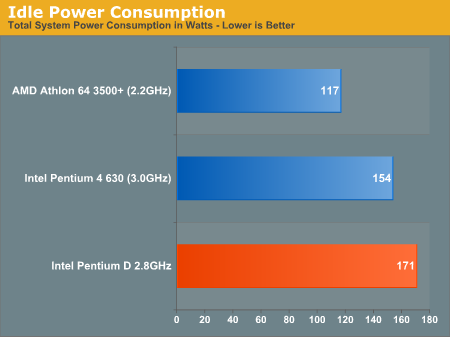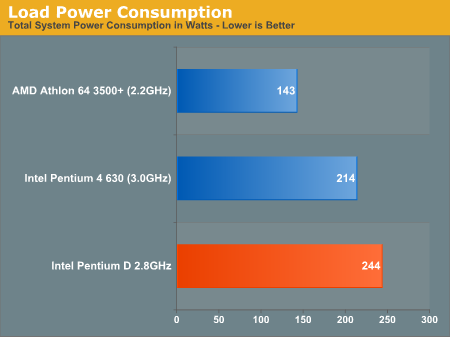Intel Dual Core Performance Preview Part II: A Deeper Look
by Anand Lal Shimpi on April 6, 2005 12:23 PM EST- Posted in
- CPUs
I'll admit, dual core has me excited for many of the reasons outlined in Part I. A big part is that personally, I've been using multiprocessor systems in my main computer for years. I've always appreciated the benefits of multiprocessor platforms, but recommending one for a desktop user has never been really feasible. Even the cheapest 2P workstation motherboards were at least twice the price of a desktop motherboard, not to mention the cost of the CPUs. The mass market had a short affair with multiprocessing in the days of the ABIT BP6 and the Celeron 300A, but in the grand scheme of things, that was barely a blip on the radar. Now, for the first time, both AMD and Intel are ready to bring the type of robustness of multiprocessor platforms to the desktop with their dual core offerings.
Part I focused on what dual core can offer, but now it's time for a much more practical look. We've never recommended Intel's Extreme Edition line of processors nor AMD's FX series, both supposedly marketed to gamers, but not purchased by any of our gaming readers. The processors that we recommend are usually much better values for the price, and thus, today's comparison isn't based around the most expensive dual core offerings, but rather the cheapest.
A point we made in the first article was that Intel's pricing strategy for dual core is extremely aggressive, with the cheapest 2.8GHz Pentium D soon to be introduced at $241. The problem is that at only 2.8GHz, the Pentium D won't have the strongest single threaded performance, which puts buyers in a sticky situation - do you buy an Athlon 64 3500+ for great single threaded performance or will the Pentium D give you a better overall multitasking experience? Intel doesn't do much to complicate the situation, as the Pentium D 2.8GHz will be close in price to the Pentium 4 630 (3.0GHz), which isn't much of a clock speed advantage. AMD will eventually have competitively priced dual core parts, but right now, AMD doesn't appear to be looking at the mainstream desktop market for dual core Athlon 64 chips.
The three chips mentioned above are the basis of the majority of today's comparison, but the decision is far from clear cut. Let's find out why.
Power Consumption
We'll start with power consumption - the contenders? A 90nm Athlon 64 3500+ vs. the Pentium 4 630 and the dual core 2.8GHz Pentium D. As always, we measured total system power at two states: idle and under a full load. For our full load test, we used a multithreaded application, 3ds max 7, performing the CBALLS2 render test from the SPECapc benchmark.


The K8 architecture simply lends itself to lower power consumptions than Intel's high frequency approach to computing with the Pentium 4 (especially Prescott). The move down to 90nm really reduced AMD's power consumption a lot, to the point where the 90nm Athlon 64 3500+ actually consumes less power under full load than the Pentium 4 630 at idle.
The Pentium 4 vs. Pentium D comparison is also interesting, as the 2nd core doesn't add all that much to overall system power consumption. In this case, we're looking at an increase in overall system power consumption by less than 15%. Intel still doesn't win in the power consumption department though; if you want something cool and quiet, AMD is still the way to go.
The Test
Our hardware configurations are similar to what we've used in previous comparisons.
AMD Athlon 64 Configuration
Socket-939 Athlon 64 CPUs
2 x 512MB OCZ PC3200 EL Dual Channel DIMMs 2-2-2-10
NVIDIA nForce4 Reference Motherboard
ATI Radeon X850 XT PCI Express
Intel Pentium 4 Configuration
LGA-775 Intel Pentium 4 and Extreme Edition CPUs
2 x 512MB Crucial DDR-II 533 Dual Channel DIMMs 3-2-2-12
Intel 955X Motherboard
ATI Radeon X850 XT PCI Express










106 Comments
View All Comments
justly - Thursday, April 7, 2005 - link
#84 What do you consider "very soon"?
The following was quoted from "part 1".
"Make no mistake, Intel isn't officially releasing their dual core desktop processors today; this is merely a preview. Intel's dual core line is still on track to be released sometime in the April - June timeframe."
IF it where to be released in April then there should have been more reviews (sorry, previews).
IF it comes out in May then there is no need to do a preview this early (except to gain marketing hype).
IF it comes out in June then a "preview" this early should have contained technical information about the chip with a "review" containing benchmarks at a later date closer to its release date.
jojo4u - Thursday, April 7, 2005 - link
Was Cool'n'Quiet enabled at the power draw test?fitten - Thursday, April 7, 2005 - link
#81, Intel publicly stated that implementing HT on the P4 was about a 5% increase in logic/area on the chip. While it may be "ugly" and such, 5% certainly isn't that much of area when you consider how much area other functionality takes up.#82, I haven't seen anyone announce duel core products. Dual core products, however, should be out very soon from Intel (and are [p]reviewed in the article this discussion is attached) for example). ;)
Kagjes - Thursday, April 7, 2005 - link
I must say i really can't relate to any of these multitasking scenorios. Well, except the teamspeak-gaming part.What would be most interesting for me is dual-core, dual monitor setup. That would ROCK, and i'm really suprised noone remembered that. For instance, playing a divx on 1 monitor while gaming on other. Or watching TV on 1 while gaming on other (i do that a lot, if the football match is boring). These tasks are pretty much repeatable and can be measured. I was thinking about getting another monitor for these kind of purposes, but i'm not sure on how would my comp react to that kind of stress.
justly - Thursday, April 7, 2005 - link
My personal thoughts about publishing an article on a duel core that is not yet availabile, nor will be for awhile, is that it is strictly marketing hype similar to what happened with the 1.13 GHz P3 or any other product that we the consumer have to wait for.The idea that duel core would have a benifit in multitasking or multithreaded apps could have easily been demonstrated on a multiprocessor system using Opterons or Xeons. So now we get a review full of new (wow factor) benchmarks describing the new found benifit of having two processors working together.
I have no real problem with "preview" style articles, but having a plethora of benchmaks in a "preview" is pointless unless the goal is to advertise (hype) a product. The only people I see having any use for this "perview" are the ones that desperately want proof that their manufacturer of choice (this time being Intel) is superior, or those people who are so fickle that they will support the newest thing on the block no matter if it is needed, affordable or even the best option at the time it becomes available.
Quanticles - Thursday, April 7, 2005 - link
Ive heard that HT is very ugly to impliment, you have to tear everything up. I'm not sure HT is very useful when you have dual core anyway.fitten - Thursday, April 7, 2005 - link
#47, if HT is simply a "bandaid", then why is AMD the only major CPU vendor not using it? IBM uses it heavily in their Power5, Sun is making their next CPUs (Niagra) very highly SMT (same thing as HT). Arguably, both of those architectures have much more shallow pipelines than the P4, yet see reason to provide SMT. AMD is the only holdout.dougSF30 - Thursday, April 7, 2005 - link
Make that 2.4GHz in Q3 (not Q4) for the DC Opti 2.4GHz.dougSF30 - Thursday, April 7, 2005 - link
DC A64 samples are at 2.4GHz, not 2.2GHz.DC Opteron is supposedly launching at up to 2.2GHz in a couple weeks, and will be available at 2.4GHz in Q4.
DC Opteron fits in 95W TDP, DC A64 gets a 110W TDP.
Both are apparently 2 x 1MB L2, per the Italian site that put the CeBIT-timed article about the DC A64 sample.
dparish - Thursday, April 7, 2005 - link
Great article. I am confused by one piece:From page 8:
Seagate Barracuda 7200.7 NCQ - 25.2 minutes
Seagate Barracuda 7200.7 no NCQ - 33.6 minutes
Western Digital Raptor WD740 - 30.9 minutes
I'm shocked that the WD740 is slower. Isn't this the NCQ enabled 10,000 rpm drive? I would have expected this to beat out the 7200.7 NCQ seagate. Any reason why the WD740 would be slower?
Another point / comment:
Is it possible that DVD Shrink is slower on the AMD's because it has not been compiled / optimized for the AMD? Would this be any different on the 64 bit version of XP if DVD Shrink was compiled for 64 bit? Of course this may be moot as DVD Shrink is not longer being developed by the author.
-Dave